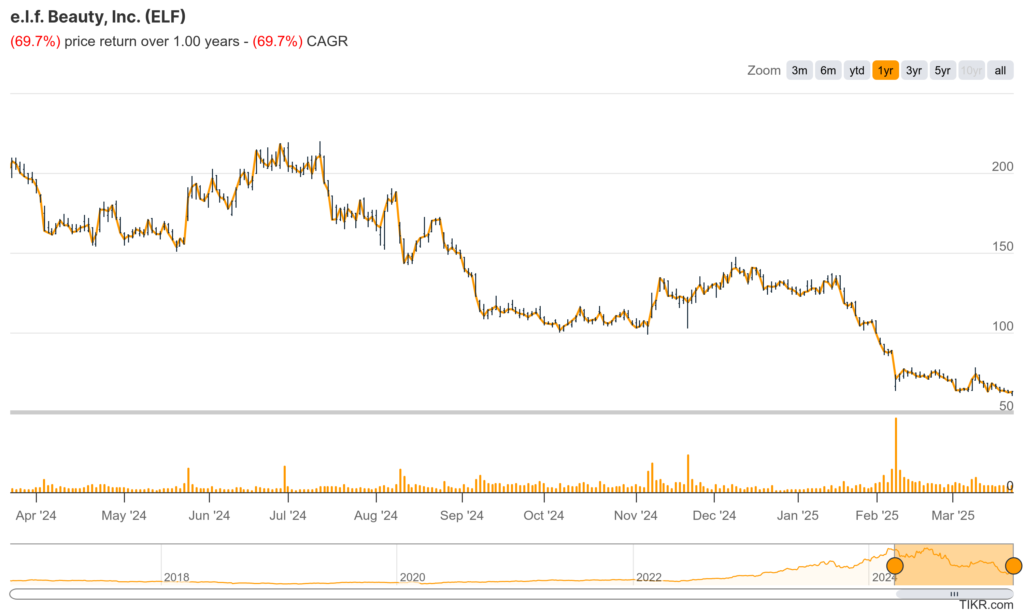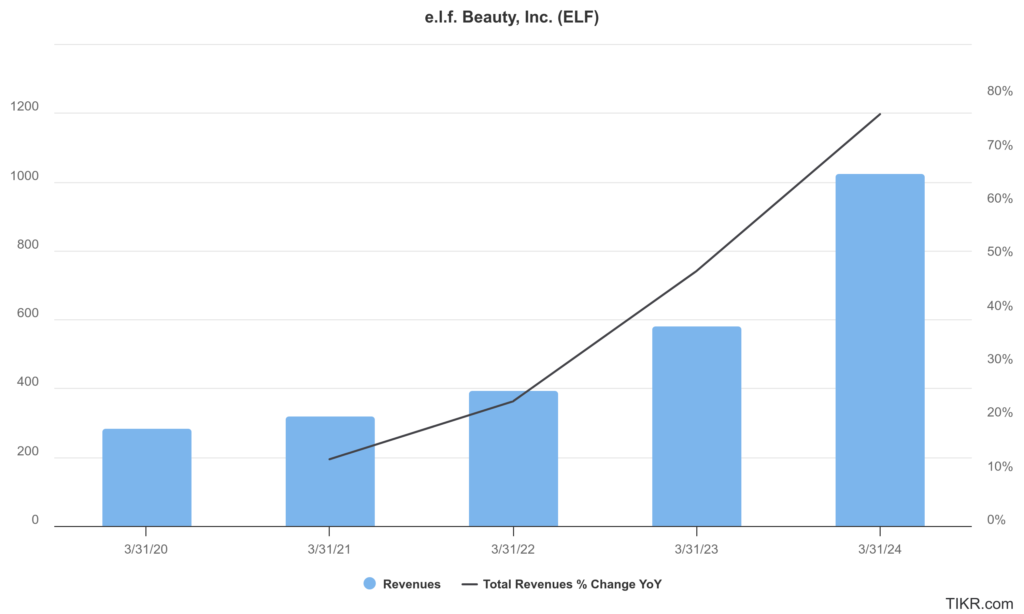Executive Summary:
e.l.f. Beauty, Inc. is a prominent American cosmetics company known for its accessible and affordable makeup and skincare products. The company has cultivated a strong reputation for offering cruelty-free and vegan products, appealing to a broad consumer base. The company’s portfolio includes various brands, such as e.l.f. Cosmetics, e.l.f. SKIN, WELL People, and Keys Soulcare, demonstrate a diverse approach to the beauty market.

e.l.f. Beauty released its net sales increased by 31% to $355.3 million. The company also demonstrated growth in market share within the U.S., gaining 220 basis points. Adjusted diluted earnings per share were reported at $0.74.
Stock Overview:
| Ticker | $ELF | Price | $62.85 | Market Cap | $3.54B |
| 52 Week High | $219.77 | 52 Week Low | $60.35 | Shares outstanding | 56.4M |

Company background:
e.l.f. Beauty, Inc. is a well-established American cosmetics company that has made strides in the beauty industry. Founded in 2004 by Joseph Shamah and Scott Vincent Borba, the company’s initial vision was to provide high-quality, affordable cosmetics to a broad consumer base. This foundation has allowed e.l.f. to cultivate a strong market presence. The company is headquartered in Oakland, California.

e.l.f. Beauty has distinguished itself by focusing on cruelty-free and vegan products, appealing to an increasingly conscious consumer market. Their product range is extensive, encompassing makeup, skincare, and bath products. Key brands within their portfolio include e.l.f. Cosmetics, e.l.f. SKIN, WELL People, and Keys Soulcare, demonstrate a diverse approach to catering to various consumer needs.
Some of its key competitors include companies that produce mass-market cosmetics, and also those that produce higher-end cosmetics. To name a few examples, companies such as Maybelline, L’Oréal, and CoverGirl are considered competitors. e.l.f. Beauty has carved out a unique position by offering quality products at accessible price points, combined with a strong emphasis on ethical practices.
Recent Earnings:
e.l.f. Beauty reported net sales of $355.3 million, marking a substantial 31% increase compared to the same period in the previous year. The company’s strategic focus on innovation, digital engagement, and effective marketing campaigns has contributed significantly to this impressive revenue trajectory.
e.l.f. Beauty delivered adjusted diluted earnings per share (EPS) of $0.74. Beauty has consistently outperformed analyst consensus estimates, showcasing its ability to execute its business strategy effectively and generate consistent financial results. This trend of exceeding expectations has reinforced investor confidence in the company’s long-term growth potential.
The company reported market share gains within the U.S., increasing by 220 basis points. This expansion is a testament to e.l.f.’s ability to resonate with consumers and effectively compete in the competitive beauty market. The company anticipates maintaining its strong momentum through strategic initiatives, including product innovation and targeted marketing efforts. The company’s management has expressed confidence in their ability to continue to gain market share, and to continue to grow sales and profitability.
The Market, Industry, and Competitors:

e.l.f. Beauty operates within the dynamic and rapidly evolving global cosmetics market, a segment characterized by continuous innovation, shifting consumer preferences, and increasing digital influence. This market encompasses a wide array of products, including makeup, skincare, haircare, and personal care items, catering to diverse demographics and needs. The beauty industry is driven by factors such as social media trends, celebrity endorsements, and a growing emphasis on ethical and sustainable practices, including cruelty-free and vegan formulations, which align with e.l.f. Beauty’s core values. The market is also experiencing a significant surge in e-commerce, allowing companies like e.l.f. to expand their reach and engage with consumers through online platforms.
A healthy Compound Annual Growth Rate (CAGR) for the industry, is driven by factors such as rising disposable incomes, increasing awareness of personal grooming, and the influence of social media. Forecasts suggest that the market could witness a CAGR of roughly 5-7% through 2030, with variations depending on specific product categories and regional markets. This growth trajectory presents significant opportunities for companies like e.l.f. Beauty has demonstrated its ability to capitalize on emerging trends and adapt to evolving consumer demands. e.l.f.’s focus on accessibility, digital engagement, and ethical practices positions it favorably to capture a larger share of this expanding market.
Unique differentiation:
e.l.f. Beauty operates within a highly competitive landscape, facing challenges from both established giants and emerging brands in the cosmetics industry.
- Mass-Market Brands: Companies like Maybelline, L’Oréal, and CoverGirl are significant competitors, offering a wide array of affordable cosmetics available in numerous retail locations. These brands have established strong market presence and brand recognition. Wet n Wild, and NYX Cosmetics also compete in this mass market area, and have similar price points to e.l.f.
- Other Competitors: There are also companies that focus on “clean beauty” products, and vegan and cruelty free products, that compete with e.l.f. companies like Pacifica Beauty, and Thrive Causemetics, compete in that market area. Also companies that are contract manufactures of beauty products, like Arcaea, Voyant Beauty and MANA Products.
e.l.f. Beauty distinguishes itself through its focus on affordability, accessibility, and ethical practices, particularly its commitment to cruelty-free and vegan products. This strategy allows them to capture a significant portion of the market, particularly among younger, socially conscious consumers. However, the company must continually innovate and adapt to evolving consumer preferences to maintain its competitive edge.

Ethical and Clean Beauty: The company’s strong commitment to cruelty-free and vegan products aligns with the growing consumer demand for ethical and sustainable beauty options. This dedication to “clean beauty” resonates with socially conscious shoppers.
Digital Proficiency and Trend Responsiveness: e.l.f. excels in digital marketing and social media engagement, enabling them to quickly capitalize on emerging trends and connect with their target audience. Their ability to rapidly bring trend-driven products to the mass market is a significant advantage.
Inclusivity: e.l.f. Beauty has highly focused on inclusiveness, and making their products available to a wide variety of people.
Management & Employees:
Tarang Amin, Chairman and Chief Executive Officer: Amin has been instrumental in the company’s transformation and growth. He’s credited with driving the brand’s digital-first strategy and expanding its product portfolio. His leadership has focused on innovation, accessibility, and ethical practices.
Kory Marchisotto, Chief Marketing Officer: Marchisotto is responsible for the companies marketing strategy. She has helped to drive the companies digital first marketing approach, and also has helped to grow the brand awareness of e.l.f.
Dionisio Aristides, Chief Operating Officer: Aristides is responsible for the operations of e.l.f. Beauty, and contributes to the companies supply chain, and logistics.
Financials:

e.l.f. Beauty Inc. has reported revenues of approximately $282.9 million, which surged to about $1.024 billion by 2024. This represents a compound annual growth rate (CAGR) of approximately 37.93%. The company’s revenue growth reflects a strong brand presence in the cosmetics industry, driven by innovative product offerings and strategic marketing initiatives.
Starting at around $17.88 million in 2020, e.l.f.’s net income soared to approximately $127.7 million by 2024, resulting in an impressive CAGR of about 63.48%. This substantial earnings growth indicates not only increased sales but also improved operational efficiency and cost management strategies that have enhanced profitability.
The total assets were reported at approximately $1.129 billion, with total liabilities standing at around $642.6 million. The steady increase in cash and cash equivalents indicates robust liquidity, allowing e.l.f. to invest in future growth initiatives while managing operational needs.
Overall, e.l.f. Beauty Inc illustrates a compelling growth trajectory characterized by strong revenue and earnings increases, alongside a solid balance sheet that supports ongoing expansion efforts in the competitive beauty market. The company’s strategic focus on innovation and consumer engagement continues to drive its success in the cosmetics industry.

Technical Analysis:
The stock is in a stage 4 decline (bearish) on all 3 monthly, weekly and daily timeframes. The outlook for the retest of the $64 range looks like it might reverse, but the more likely probability is a move lower to the $50s.

Bull Case:
Effective Growth Strategy: e.l.f. Beauty has demonstrated a consistent ability to expand its market share through strategic product innovation, effective marketing, and expanding distribution channels. Their ability to quickly adapt to trends, and bring new products to market, is a large part of their success. The company has also shown that they are able to expand their brand portfolio, to reach a wider range of consumers.
Financial Performance: e.l.f. Beauty has delivered strong financial results, consistently exceeding analyst expectations for revenue and earnings growth. Although recent news has caused a stock decline, the companies ability to grow sales, and to grow market share, is still very strong.
Bear Case:
Consumer Trend Volatility: Beauty trends are notoriously fickle. A sudden shift in consumer preferences away from e.l.f.’s core product offerings could negatively impact sales. Reliance on social media trends can be a double-edged sword. While it fuels growth, it also exposes the company to rapid changes in consumer tastes.
Supply Chain and Economic Risks: Disruptions in the global supply chain, rising inflation, or economic downturns could negatively affect e.l.f.’s production costs and consumer spending. These factors could lead to reduced profit margins and slower sales growth.
